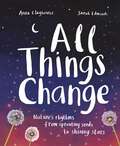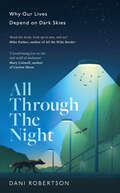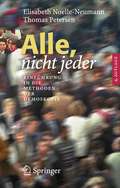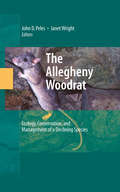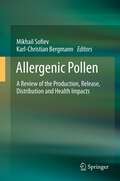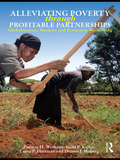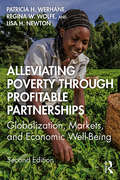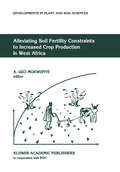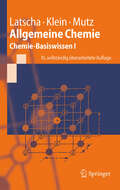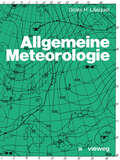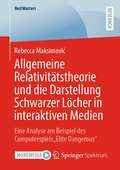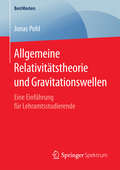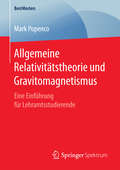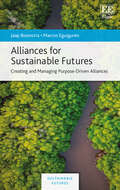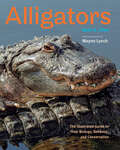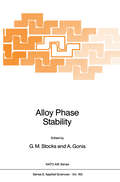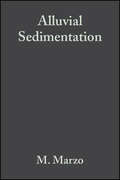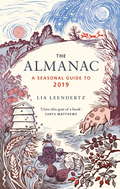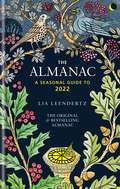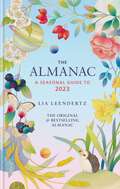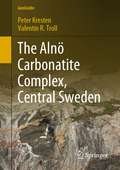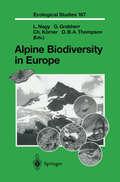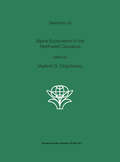- Table View
- List View
All Things Change: Nature's rhythms, from sprouting seeds to shining stars
by Anna ClaybourneEverything changes. From the birth of new stars to the endlessly shifting tides and tiniest life cycle. Some change happens right before your eyes, while other transformations happen so slowly that you won't notice them in your lifetime. And you change too, just like everything else in Nature – growing, learning and changing your thoughts and feelings.All Things Change is a lyrical and beautifully illustrated book looking at the many different processes of change in the natural world, covering geology, ecology, biology and more. It also embraces the philosophical topic of change – how do we approach changes that make us feel sad? How do we cope with changes we can't control? Ideal for children to explore independently or with parents, it holds a special appeal for anyone struggling to find stability in a rapidly changing world.
All Through the Night: Why Our Lives Depend On Dark Skies
by Dani RobertsonBest New Books on Space 2024 – Forbes ‘Rarely is a non-fiction book about science this engaging’ – Forbes
Alle, nicht jeder: Einführung in die Methoden der Demoskopie
by Elisabeth Noelle-Neumann Thomas PetersenAllein mit der Beobachtungsgabe können wir die soziale Wi- lichkeit nicht wahrnehmen. Wir müssen uns mit Geräten aus- sten, die unsere natürlichen Fähigkeiten verstärken, so wie es für die Beobachtung der Natur längst geschehen ist. Umfragen sind ein solches Hilfsmittel, seit dem Ende des 18. Jahrhunderts mühsam methodisch entwickelt, mit eigen- tigen Verzögerungen, gegen beharrliche Widerstände. »Die empirische Tradition der Erforschung von Meinungen und Einstellungen begann – recht bescheiden – in Deutschland«, schrieb der Pionier der modernen Sozialforschung Paul 1 Lazarsfeld. Aber die Tradition der deutschen Umfragen des 19. und frühen 20. Jahrhunderts war völlig abgerissen und so gut wie vergessen, als nach 1945 Bevölkerungsumfragen in Deutschland wieder aufkamen. Man hielt sie für eine ameri- nische Erfindung. Das neue Beobachtungsinstrument wurde kaum mit Freude begrüßt, nicht als Fortschritt menschlicher Erkenntnismögli- keiten gepriesen. Es weckte Unbehagen. Man wunderte sich, warum plötzlich überall Umfrageergebnisse erschienen, in Z- tungen und im Rundfunk, in den politischen Reden ebenso wie in den Geschäftspapieren der Firmen. Zeitweise dachte man, es sei eine Mode. Heute sind Umfragen aus dem politischen und dem Wi- schaftsleben und aus vielen anderen Bereichen nicht mehr w- zudenken. Doch das Mißtrauen in der Öffentlichkeit ist gebl- ben.
The Allegheny Woodrat: Ecology, Conservation, and Management of a Declining Species
by Janet Wright John D. PelesA decline in populations of Allegheny woodrats (Neotoma magister) was first noticed in the 1980s. Since that time, woodrats have become extirpated from at least two states and have declined dramatically in several others. Recent evidence suggests that the decline of this species may be proceeding further south to include states where woodrat populations were previously considered to be stable. The Allegheny Woodrat: Ecology, Conservation, and Management of a Declining Species provides a comprehensive summary of research conducted over the past twenty-five years. The book integrates the results of this research into a comprehensive picture of the ecological requirements, conservation principles, and management strategies for this declining species. In addition, general principles learned from the study of woodrats are applied to the conservation and management of other declining species, including other species of Neotoma. The editors and chapter authors are researchers from both academic settings and state management agencies, individuals who have contributed significantly to the study of Allegheny woodrats during the past two decades. The book will be of interest to ecologists, conservation biologists, wildlife professionals, and students.
Allergenic Pollen: A Review of the Production, Release, Distribution and Health Impacts
by Mikhail Sofiev and Karl-Christian BergmannThis is the first book to summarize all aspects of allergenic pollen: production, atmospheric distribution, and health impacts, as well as the means of monitoring and forecasting these phenomena. Based on a four-year effort by a large group of leading European scientists, this book highlights the new developments in research on allergenic pollen, including the modelling prospects and effects of climate change. The multidisciplinary team of authors offers insights into the latest technology of detection of pollen and its allergenic properties, forecasting methods, and the influence of allergenic pollen on the population. The comprehensive coverage in this book makes it an indispensible volume for anyone dealing with allergenic pollen worldwide. Readers involved in environmental health, aerobiology, medicine, and plant science will find this book of interest.
Alleviating Poverty Through Profitable Partnerships: Globalization, Markets, and Economic Well-Being
by Patricia H. WerhaneIn this book, the authors approach poverty alleviation from an atypical perspective. The thesis is that poverty can be reduced, if not eradicated, both locally and globally, but this will occur only if we change our shared narratives about global free enterprise, and only if we recalibrate our mindsets regarding how poverty issues are most effectively addressed. They argue that poverty amelioration cannot be effected by the traditional means employed during the last century—foreign aid from developed nations and/or from non-profit international organizations. Rather, the authors present evidence which demonstrates that a mindset embracing initiatives developed by global corporations in response to the poverty challenge is significantly more effective. Global companies can alleviate poverty by seizing market opportunities at the Base of the economic Pyramid (BoP) with the implementation of three key processes: moral imagination, systems thinking, and deep dialogue. This approach to alleviating poverty offers some powerful ideas backed by the support of some of the leading Business Ethics minds in the United States. These scholars, some of whom are on the author team, have created a book that is unique and provocative yet still ideal for courses at the undergraduate level.
Alleviating Poverty Through Profitable Partnerships 2e: Globalization, Markets, and Economic Well-Being
by Patricia H. Werhane Lisa H. Newton Regina WolfePoverty is an unnecessary form of human degradation and badly conceived economics. Our thesis is that poverty can be reduced, if not eradicated, both locally and globally. But this will occur only if we change our shared narratives about global free enterprise, remind ourselves that poverty is a system, and conceive of poverty alleviation as a "bottom up" project. There is no "one size fits all" for poverty reduction. Rather, poverty is a system and must be addressed locally. It is our aim, as it is the aim of the United Nations, the World Bank, and many other organizations, to erase it from our vocabulary and from this planet. With a series of case studies that accompany each chapter, this book should assist readers in thinking about poverty alleviation from a number of perspectives, from bottom-up entrepreneurial projects, local-corporate ventures, with public-private partnerships, from focused philanthropy, with education and health care initiatives, and agriculture reforms in rural communities, all with creating a win-win for local and partnership individuals, organizations, and communities.. The book should be useful in various undergraduate and graduate courses on ethics, applied ethics. developing economic systems, and on poverty.
Alleviating Poverty Through Profitable Partnerships 2e: Globalization, Markets, and Economic Well-Being
by Patricia H. Werhane Lisa H. Newton Regina WolfePoverty is an unnecessary form of human degradation and badly conceived economics. Our thesis is that poverty can be reduced, if not eradicated, both locally and globally. But this will occur only if we change our shared narratives about global free enterprise, remind ourselves that poverty is a system, and conceive of poverty alleviation as a "bottom up" project. There is no "one size fits all" for poverty reduction. Rather, poverty is a system and must be addressed locally. It is our aim, as it is the aim of the United Nations, the World Bank, and many other organizations, to erase it from our vocabulary and from this planet. With a series of case studies that accompany each chapter, this book should assist readers in thinking about poverty alleviation from a number of perspectives, from bottom-up entrepreneurial projects, local-corporate ventures, with public-private partnerships, from focused philanthropy, with education and health care initiatives, and agriculture reforms in rural communities, all with creating a win-win for local and partnership individuals, organizations, and communities.. The book should be useful in various undergraduate and graduate courses on ethics, applied ethics. developing economic systems, and on poverty.
Alleviating Soil Fertility Constraints to Increased Crop Production in West Africa (Developments in Plant and Soil Sciences #47)
by A. Uzo MokwunyeTropical Africa escaped from the glaciers that covered the temperate parts of the world during the Ice Age. The legacy is that most of the parent materials of the soils of tropical Africa are old, highly weathered and devoid of bases and phosphate-bearing minerals. Traditional farming systems which were relatively stable and sustainable relied on long fallow periods after one to two years of cropping to maintain the productive capacity of the soils. In recent times and especially in densely populated areas, a sizeable class of 'landless' farmers have begun to cultivate marginal lands or to invade the 'forest reserves' thereby exacerbating the problems of land and environ mental degradation. of soil fertility that will facilitate the production of adequate quantities of the principle Maintaining a level staples has become a major challenge to agricultural scientists in tropical Africa. To increase the nutrient supplying power of soils requires the inputs of fertilizers. These can be organic or inorganic. The efficiency with which these externally supplied inputs can increase agricultural production and reduce soil and environmental deterioration is dependent on the ability of scientists to determine the right types and quantities of the products to apply to each soil, crop and cropping system as well as the ability of farmers to acquire requisite farm manage ment skills.
Allgemeine Chemie: Chemie-Basiswissen I (Springer-Lehrbuch)
by Hans Peter Latscha Helmut Alfons Klein Martin MutzDer erste Band der Reihe „Chemie-Basiswissen“ vermittelt die allgemeinen Grundlagen der Chemie für Bachelor-Studiengänge sowie für Studierende des höheren Lehramts. Die Autoren präsentieren die am Curriculum orientierte Stoffauswahl in kurzer und übersichtlicher Form und in einem lernfreundlichen Layout. In der 10. Auflage sind die Inhalte noch genauer auf die Bedürfnisse der Studierenden zugeschnitten. Zu der für das Hauptfach Chemie darüber hinaus erforderlichen Chemie der Elemente ist jetzt ein eigener, vierter Band erschienen.
Allgemeine Meteorologie
by Gösta H. LiljequistDieses Buch ist als Einführung in die Meteorologie gedacht. Es informiert über die ver schiedenen Prozesse in der Atmosphäre der Erde. Das Buch sollte in erster Linie als Lehrbuch für den akademischen Unterricht in Meteorologie dienen, kann aber auch in anderen Wissenschaftszweigen, wie z. B. in der Geographie, Verwendung finden. Für das Verständnis des Buches sind nur die Gymnasialkenntnisse der Mathematik nötig. Selbst Leser ohne eigentliche Mathematikkenntnisse können sich daraus das Wesentliche aneignen. Die ersten 22 Kapitel des Buches kommen in logischer Abfolge; es werden zunächst die einfachen meteorologischen Grundbegriffe eingeführt, die im folgenden angewendet werden. Die Schlußkapitel 23 bis 27 haben einen mehr vervollständigenden und informativen Charakter. Die schwedische Ausgabe dieses Buches erschien 1962 und wurde seither als Lehrbuch im Meteorologiestudium an schwedischen Universitäten verwendet. Mit den dabei ge wonnenen Erfahrungen wurde die deutsche Ausgabe überarbeitet und modernisiert. Außerdem wurde das Buch in mancher Hinsicht für Studierende in Mitteleuropa an gepaßt, vor allem, was die Diskussion der Wetterlagen und die Illustrationen betrifft. Universitätsdozent Dr. Konrad Cehak, Wien, hat nicht nur die Übersetzung vorgenommen, sondern hat auch große Teile der Revision des Buches ausgeführt. Ich bin für die frucht bare und angenehme Zusammenarbeit, die wir dabei hatten, sehr dankbar, ebenso auch meinen schwedischen Kollegen für viele Ratschläge während der Abfassung des Buches. Besonders möchte ich meinen Dank Herrn Professor Tor Bergeron und Universitätslektor Birger Svensson, Uppsala, ausdrücken. Gösta H. Li/jequist Inhaltsverzeichnis 1. Einleitung 4 Die Gasgesetze 2. Einheiten für Temperatur und Druck 4 2.1.
Allgemeine Relativitätstheorie und die Darstellung Schwarzer Löcher in interaktiven Medien: Eine Analyse am Beispiel des Computerspiels „Elite Dangerous“ (BestMasters)
by Rebecca MaksimovićDie Darstellungen von Schwarzen Löcher in Büchern, im Fernsehen und in Computerspielen prägen die Vorstellungen der Öffentlichkeit über Astrophysik und die Allgemeine Relativitätstheorie (ART). Deshalb stellt sich die spannende Frage, inwiefern die Darstellungen der Wissenschaft entsprechen. Das vorliegende Buch geht dieser Frage nach, indem zwei Effekte der ART an Schwarzen Löchern, die Lichtablenkung und die gravitative Rotverschiebung, exemplarisch in dem Computerspiel „Elite Dangerous“ untersucht werden. Dafür wird zuerst die ART elementar eingeführt und auf Grundlage der Theorie werden schwarze Löcher und ihre Effekte beschrieben. Danach wird dieses Fachwissen auf Bildausschnitte des Computerspiels angewendet und diese untersucht. Ein besonderes Augenmerk wird dabei auf eine möglichst nachvollziehbare kleinschrittige Darstellung mit anschaulichen Beispielen gelegt, sodass die Arbeit auch für Lehramtsstudierende und Lehrkräfte gut verständlich ist.
Allgemeine Relativitätstheorie und Gravitationswellen: Eine Einführung für Lehramtsstudierende (BestMasters)
by Jonas PohlJonas Pohl liefert eine didaktisch aufbereitete Einführung in die Gedankenwelt der Allgemeinen Relativitätstheorie. Er gibt einen Einblick in die Grundlagen von 100 Jahren Relativitätstheorie und spannt dabei den Bogen von der Speziellen Relativitätstheorie im Jahr 1905 bis hin zum aktuellsten Ereignis, der Entdeckung der Gravitationswellen im Frühjahr 2015. Der Autor bietet damit besonders Studierenden des Lehramts die Möglichkeit, die Essenz der Allgemeinen Relativitätstheorie in verständlicher und nachvollziehbarer Weise zu erfassen.
Allgemeine Relativitätstheorie und Gravitomagnetismus: Eine Einführung für Lehramtsstudierende (BestMasters)
by Mark PopencoMark Popenco gibt Einblick in eines der faszinierendsten Gedankengebäude der theoretischen Physik: die Allgemeine Relativitätstheorie. Er stellt systematisch – unter Betrachtung von Analogien zur Elektrodynamik – Einsteins Relativitätstheorie dar und widmet sich anschließend der Untersuchung gravitomagnetischer Effekte, die während der „Gravity Probe B“-Satellitenmission erstmals experimentell nachgewiesen worden sind. Das schrittweise auf Verständnis ausgelegte Vorgehen eignet sich deshalb insbesondere für Lehramtsstudierende der Physik.
Allgemeine Völkerkunde: Formen und Entwicklung der Kultur
by Kunz DittmerDie Völkerkunde rückt mit den anderen Wissenschaften vom Men schen gegenwärtig im In-und Ausland mehr und mehr in den Vorder grund des Interesses. Die Ergebnisse ihrer Forschungen erhalten vor allem aus folgenden Gründen immer gröEeres Gewicht: Wir stellen uns gerade in Krisenzeiten die Frage: Was ist der Mensch, welche geistigen und seelischen Möglichkeiten und Begrenzungen, aber auch welche zum Miteinanderleben und zur Entfaltung seiner Kultur sind ihm gegeben? Wo stehen wir selbst? Der Besinnung auf uns selbst genügt aber nur ein Erkennen der vergangenen und der gegenwärtigen Formen und Kräfte unserer eigenen Kultur nicht, sondern es ist dazu ein Kennenlernen auch der fremden Völker, ihrer geistig-seelischen Veranlagung, des Wesens und Werdens ihrer Kulturen erforderlich. Erst dann können wir abwägen, was allen Menschen gemeinsam ist und sie verbindet, worin die Unterschiede zwischen ihnen bestehen und auf welche Ursachen diese sich gründen mögen. Dann aber wird sich im fremden Wesen das eigene urn so klarer spiegeIn. Die moderne Weltwirtschaft verflicht alle Gebiete der Erde in einen immer engeren Zusammenhang und politische Ereignisse im fernsten Winkel lassen ihre Rückwirkungen auf den ganzen Weltkreis spüren. Urn zu den aktuellen Ereignissen Stellung nehmen und sie nach ihrer Bedeutung und Entstehung richtig einschätzen zu können, ist also ebenfalls eine sachliche Unterrichtung über alle Völker der Erde, ihre Kultur und Geschichte unerläBlich.
Alliances for Sustainable Futures: Creating and Managing Purpose-Driven Alliances (Sustainable Futures)
by Jaap Boonstra Marcos EguigurenProviding an in-depth exploration of the formation, building, development, and evolutionary phases of sustainable alliances, this book presents a new perspective on organizational change that goes beyond modern institutions and offers practical insights on how to cope with paradoxes in the life cycle of alliances. Combining theoretical ideas, practical concepts, and critical reflections on the topic, this insightful and timely book supports the conception and progression of purpose-driven alliances which contribute to a more positive and sustainable world. The authors present a historical overview of alliances, as well as discussing the factors pertaining to the successes and failures of collaborating organizations. The book further outlines the life cycle of sustainable alliances, using the Global Alliance in Management Education (CEMS) and the Global Alliance for Banking on Values (GABV) as contemporary case studies. Analysing the strength and scope of alliances, it explores opportunities for these partnerships to contribute to a sustainable future. Offering inspiration and guidance for those looking to contribute to profound economic and social change, this book will be an invaluable resource for students and scholars of business management, international business, and sustainable development, as well as the new generation of business people. It will also be beneficial for consultants, leaders, and managers who are dedicated to the creation and development of global alliances.
Alligators: The Illustrated Guide to Their Biology, Behavior, and Conservation
by Kent A. VlietFew scenes put the senses on edge more than a submerged alligator, only eyes and snout showing, when peering across a southern lake on a misty morning. An iconic American predator, these reptiles grow to thirteen feet or more and can live as long as humans. Alligators are complex creatures, capable of terrific attacks and yet tending to their young in the same gentle way a mother duck looks after her brood. Once extremely numerous, alligators came close to extinction in the twentieth century, but thanks to conservation efforts have since made a comeback, reclaiming their rightful place as the monarchs of the southern wetlands.In this fascinating account, richly illustrated with more than 150 photographs from award-winning wildlife photographer Wayne Lynch, expert zoologist Kent A. Vliet introduces readers to the biology, ecology, and natural history of the American alligator. Sharing nuanced depictions of their hidden lives that will forever change the way you think of these giant reptiles, the book• combines captivating storytelling with the most current scientific facts• chronicles the life cycle of the alligator• explains why the alligator's precise anatomy and physiology make it so successful• covers a wide range of topics, from courtship and reproduction to communication, basking, nest-building, and hunting• reveals the alligator's sophisticated social life in detail• evaluates the alligator's environmental role as a keystone species• examines the complicated relationship between alligators and people
Alloy Phase Stability (NATO Science Series E: #163)
by G. M. Stocks A. GonisOne of the ultimate goals of materials research is to develop a fun damental and predictive understanding of the physical and metallurgical properties of metals and alloys. Such an understanding can then be used in the design of materials having novel properties or combinations of proper ties designed to meet specific engineering applications. The development of new and useful alloy systems and the elucidation of their properties are the domain of metallurgy. Traditionally, the search for new alloy systems has been conducted largely on a trial and error basis, guided by the skill and intuition of the metallurgist, large volumes of experimental data, the principles of 19th century thermodynamics and ad hoc semi-phenomenological models. Recently, the situation has begun to change. For the first time, it is possible to understand the underlying mechanisms that control the formation of alloys and determine their properties. Today theory can begin to offer guidance in predicting the properties of alloys and in developing new alloy systems. Historically, attempts directed toward understanding phase stability and phase transitions have proceeded along distinct and seemingly diverse lines. Roughly, we can divide these approaches into the following broad categories. 1. Experimental determination of phase diagrams and related properties, 2. Thermodynamic/statistical mechanical approaches based on semi phenomenological models, and 3. Ab initio quantum mechanical methods. Metallurgists have traditionally concentrated their efforts in cate gories 1 and 2, while theoretical physicists have been preoccupied with 2 and 3.
Alluvial Sedimentation (International Association Of Sedimentologists Series #66)
by M. Marzo C. PuigdefabregasMost of the thirty-four papers contained in this Special Publication arise from the Fourth International Conference on Fluvial Sedimentology held in Spain in 1989. Sections deal with various aspects of sediment transport and hydraulics in flume experiments and modern rivers, the analysis of alluvial facies, geomorphic and structural controls on alluvial sedimentation, alluvial stratigraphy and basin analysis, and finally the exploration and exploitation of ores. A professional reference to the most recent research in fluvial sedimentology. An international expert authorship.
The Almanac: A Seasonal Guide to 2019
by Lia LeendertzTHE ORIGINAL & BESTSELLING ALMANAC 'I love this gem of a book' - Cerys Matthews 'This book is your bible' - The Independent '...it already feels like an annual necessity' - India Knight 'Joyous' - Allan Jenkins 'Updated for 2019 with more lovely ideas to celebrate the seasons' - Gardens Illustrated'A charming book. This is a real gem of a gift' - Sunday Express, S Magazine. A perfect toolkit connecting with the world around us and the year ahead as it unfolds - all in a compact and pocket size that just begs you to pick it up and browse - Reckless Gardener or Its range of information and depth of understanding of our seasons is priceless - Reckless GardenerThe Almanac: A Seasonal Guide to 2019 reinvents the tradition of the rural almanac for a new audience. It gives you the tools and inspiration you need to celebrate, mark and appreciate each month of the year in your own particular way. Divided into the 12 months, a set of tables each month gives it the feel and weight of a traditional almanac, providing practical information that gives access to the outdoors and the seasons, perfect for expeditions, meteor-spotting nights and beach holidays. There are also features on each month's unique nature, such as the meteor shower of the month, beehive behaviour, folklore and stories, seasonal recipes and charts tracking moon phases and tides. Why not try identifying trees by their bare buds in January; Enjoy Buttermilk scones with orangle blossom & honey butter in June; Discover the Chinese New Year story of 'The great race' in February.You will find yourself referring to the almanac all year long, revisiting it again and again, and looking forward to the next edition as the year draws to a close.Praise for The Almanac: A Seasonal Guide to 2018:'The perfect companion to the seasons' - India Knight'A richly layered book of events, celebrations and everyday information that together create a beautiful, fascinating resource . . . In the single month I've had my hands on it, the book has quietly "worked".' - Telegraph'Beautifully written, this pocket-sized guide is a labour of love and will remind you to appreciate little moments throughout the year.' - Gardens Illustrated'Elegant . . . an ideal stocking filler.' - The English Garden
The Almanac: A seasonal guide to 2022
by Lia Leendertz*THE ORIGINAL & BESTSELLING ALMANAC*A perfect toolkit for connecting with the world around us and the year ahead as it unfolds - all in a compact and pocket size guide that just begs you to pick it up and browse.The Almanac: A seasonal guide to 2022 reinvents the tradition of the rural almanac for a new audience. It gives you the tools and inspiration you need to celebrate, mark and appreciate each month of the year in your own particular way. Divided into the 12 months, a set of tables each month gives it the feel and weight of a traditional almanac, providing practical information that gives access to the outdoors and the seasons, perfect for expeditions, meteor-spotting nights and beach holidays. There are also features on each month's unique nature, such as the meteor shower of the month, beehive behaviour, folklore, seasonal recipes and charts tracking moon phases and tides.You will find yourself referring to The Almanac all year long, revisiting it again and again, and looking forward to the next edition as the year draws to a close.PRAISE FOR THE ALMANAC:'The perfect companion to the seasons' - India Knight'Indispensable' - Sir Bob Geldof'This book is your bible' - The Independent'An ideal stocking filler' - The English Garden'I love this gem of a book' - Cerys Matthews
The Almanac: THE SUNDAY TIMES BESTSELLER (Almanac)
by Lia LeendertzTHE ORIGINAL & SUNDAY TIMES BESTSELLING ALMANAC Reconnect with the seasons in Britain and Ireland with this month-by-month guide to the world around us - including key dates, tide tables and garden tasks; constellations and moon phases; sunrises, folk songs, seasonal recipes plus a 'bun of the month'; and - because 2023 will be a good year for planet spotting - the solar system and the zodiac.The Almanac: A Seasonal Guide to 2023 gives you the tools and inspiration you need to celebrate, mark and appreciate each month of the year in your own particular way. Divided into the 12 months, a set of tables each month gives it the feel and weight of a traditional almanac, providing practical information that gives access to the outdoors and the seasons, perfect for expeditions, meteor-spotting nights and beach holidays. There are also features on each month's unique nature, with this instalment following the swirling micro world of the garden pond through the year.You will find yourself referring to The Almanac all year long, revisiting it again and again, and looking forward to the next edition as the year draws to a close.This year's edition is illustrated by artist Whooli Chen.The geographical scope of The Almanac is Britain and IrelandPRAISE FOR THE ALMANAC:'Lia Leendertz's classic almanac never fails to delight' - The Herald'It's a perfect Christmas present' - Allan Jenkins, The Observer'The perfect companion to the seasons' - India Knight'Indispensable' - Sir Bob Geldof'This book is your bible' - The Independent'I love this gem of a book' - Cerys Matthews
The Alnö Carbonatite Complex, Central Sweden (GeoGuide)
by Valentin R. Troll Peter KrestenThis GeoGuide provides an overview of the geology of Alnö, combined with an up-to-date field itinerary. Covering all major geological aspects, it offers an essential summary of Alnö and its intriguing magmatic rocks in a compact form suitable for field excursions and home study alike. As one of the type localities for carbonatite, the late Proterozoic Alnö ring complex has been a crucial site for carbonatite-related research (next to the Fen complex in Norway), and provided one of the earliest test beds for this unique group of igneous rocks. Five geological excursions introduce the visitor to the most rewarding outcrops, including detailed descriptions and a wealth of high-quality colour photographs. The excursions are complemented by a detailed review of the history of scientific investigation on Alnö and, in particular, a catalogue of exotic and common minerals associated with the complex’s carbonatitic and alkaline silicate rocks. Finally, a summary of its trace element and isotope geochemistry as well as a brief outlook on Alnö’s potential as a future source of Rare Earth Elements (REEs) completes the book.
Alpine Biodiversity in Europe (Ecological Studies #167)
by Laszlo Nagy Georg Grabherr Christian Körner Desmond B. A. ThompsonThe United Nations Conference on the Environment and Development (UNCED), held in Rio de Janeiro in 1992, spawned a multitude of pro grammes aimed at assessing, managing and conserving the earth's biological diversity. One important issue addressed at the conference was the mountain environment. A specific feature of high mountains is the so-called alpine zone, i. e. the treeless regions at the uppermost reaches. Though covering only a very small proportion of the land surface, the alpine zone contains a rela tively large number of plants, animals, fungi and microbes which are specifi cally adapted to cold environments. This zone contributes fundamentally to the planet's biodiversity and provides many resources for mountain dwelling as well as lowland people. However, rapid and largely man-made changes are affecting mountain ecosystems, such as soil erosion, losses of habitat and genetic diversity, and climate change, all of which have to be addressed. As stated in the European Community Biodiversity Strategy, "the global scale of biodiversity reduction or losses and the interdependence of different species and ecosystems across national borders demands concerted international action". Managing biodiversity in a rational and sustainable way needs basic knowledge on its qualitative and quantitative aspects at local, regional and global scales. This is particularly true for mountains, which are distributed throughout the world and are indeed hot spots of biodiversity in absolute terms as well as relative to the surrounding lowlands.
Alpine Ecosystems in the Northwest Caucasus (Geobotany #29)
by Vladimir G. OnipchenkoPlant geographical description of the area, syntaxonomy, spatial patterns, floristic richness, structure of plant communities in relation to soil properties and herbivore influence were described for a mountain region that is difficult to access. Seasonal, inter-annual, and long-term dynamics of vegetation are discussed on the base of long-term observations as well as pollen and phytolith analyses. Population biology of alpine plants is studied by combination of field observations and mathematical modelling. Plant population strategies and soil seed banks are described for alpine plants from several communities. Results of long-term ecological experiments (plant reciprocal transplantations, dominant removals, light limitation) showed the significance of competition and facilitation for community organization. Structure of soil algal and fungal communities is represented as well as mycorrhiza of alpine plants. Main animal groups (wild) history and modern nature conservation problems are discussed.
